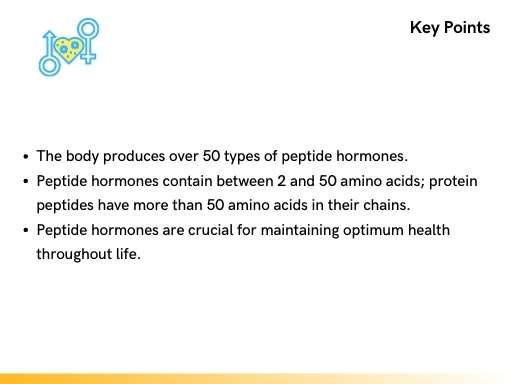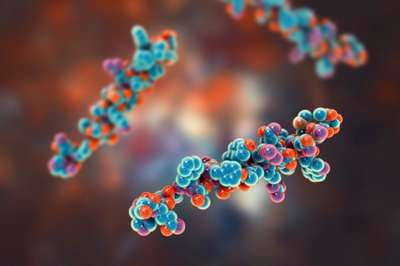 Of the four primary types of hormones in the body: amino acids, eicosanoids, peptides, and steroids, perhaps none get as much conversation as peptides.
Of the four primary types of hormones in the body: amino acids, eicosanoids, peptides, and steroids, perhaps none get as much conversation as peptides.
While all hormones play vital roles in keeping us healthy and functioning at peak performance, the peptide hormones have some of the farthest-reaching effects on the body. Peptide hormones are composed of small amino acid chains. The body produces over 50 different types of peptide hormones. As opposed to steroid hormones, produced primarily in the testes, ovaries, and adrenal glands, peptide hormones come from glands, bones, organs, and tissues throughout the body.
Definition of Peptide Hormones
Peptide hormones, composed of small chains of amino acids (polypeptide chains consisting of proteins), are often called protein hormones. The primary distinction between peptide and protein hormones is the size of the molecule chain. Peptides contain between 2 and 50 amino acids. Proteins have more than 50 amino acids in their chains, some with hundreds of amino acids.
Because of these differences in the size of their molecular chains, peptides may be less well-defined in their structure than proteins. Examples of short polypeptide chains include oxytocin and antidiuretic hormone, both released from the posterior pituitary gland.
Peptide hormones are water-soluble (hydrophilic), meaning they do not require carrier proteins to help them circulate in the bloodstream as other hormones do. Because they are water-soluble, peptide hormones are insoluble in lipids (fats). Peptides cannot pass through cell membranes, which is why their receptors are on their target cells’ surfaces.
Glycoprotein hormones are examples of complex protein hormones bearing carbohydrate side chains. Thyroid-stimulating hormone, follicle-stimulating hormone, and luteinizing hormone are examples of glycoproteins.
Peptide hormones are often short-lived, traveling in the bloodstream freely until they dissolve. Along the way, they signal receptors on their target cells to engage their actions. The breakdown of these hormones in the bloodstream ends their activities until their next release.
What Are the Types of Peptide Hormones?
With over 50 different peptide hormones circulating in the body, understanding their functions can help determine if you are experiencing problems with their production. Some peptide hormones carry out only one small role, such as atriopeptin, which is produced by the heart and serves as a vasodilator. Other peptides, such as osteocalcin, made in the bones, have numerous functions. For example, osteocalcin promotes testosterone synthesis, memory formation, muscle function, and energy expenditure. Below, we highlight a few of the peptide hormones.
Oxytocin
 Oxytocin is a small peptide hormone (9 amino acids) secreted by the posterior pituitary gland. Its production takes place in the magnocellular neurons in the hypothalamus. Oxytocin is similar in structure to vasopressin (only two amino acids different), the only other hormone secreted by the posterior pituitary gland.
Oxytocin is a small peptide hormone (9 amino acids) secreted by the posterior pituitary gland. Its production takes place in the magnocellular neurons in the hypothalamus. Oxytocin is similar in structure to vasopressin (only two amino acids different), the only other hormone secreted by the posterior pituitary gland.
Its primary functions are part of the birth cycle, stimulating uterine muscle contractions to facilitate childbirth. Oxytocin also promotes milk secretion from the milk ducts in the breasts.
Another function of oxytocin is the regulation of circadian homeostasis. Nerve cells also produce oxytocin upon sensory nerve stimulation. Oxytocin release often follows orgasm in males and females. Exercise, massage, and acts as simple as a hug can increase oxytocin release.
High levels of oxytocin and cortisol are often found in people dealing with stress or social isolation. Too much oxytocin in men over age 60 could increase the risk of benign prostatic hyperplasia and difficulty passing urine. Oxytocin’s similarity to vasopressin (antidiuretic hormone) can lead to a slight reduction in urine excretion.
Low oxytocin levels may increase the risk of autism, autistic spectrum disorders, and depression. For nursing mothers, low oxytocin may inhibit milk production and interfere with breastfeeding.
Insulin
Insulin is a longer (51 amino acid) peptide hormone produced in the beta cells of the pancreas. It is an anabolic polypeptide hormone that promotes glucose storage and regulates the metabolism of carbohydrates. Insulin signals the cellular uptake of glucose, removing sugars from the bloodstream and storing them in the liver, muscles, and fat cells.
Along with glucose regulation, insulin stimulates the fat cells to synthesize fat and tells the hypothalamus to reduce appetite by promoting leptin secretion from adipose (fat) tissue. Insulin and leptin regulate one another, with leptin increasing insulin sensitivity and decreasing the production of glucose.
Insulin is self-regulating as it responds to high blood glucose levels. Secretion continues throughout the day in small amounts. After meals, the pancreas secretes greater amounts of insulin into the bloodstream to help with transferring glucose from the food you consume into the cells for energy or storage.
Insulin resistance occurs when the body’s cells no longer respond to insulin, causing high glucose levels to remain in the bloodstream. In response, the pancreas continues secreting higher amounts of insulin to help increase glucose absorption. Obesity, heart disease, and type 2 diabetes are potential problems from insulin resistance. Type 1 diabetes is due to low insulin levels, whereas type 2 diabetes is caused by insulin resistance in the cells.
High insulin levels (hyperinsulinemia) cause blood sugar levels to get too low and present the following symptoms:
- Fatigue
- Intense or frequent hunger
- Sugar cravings
- Blurry vision
- Decreased focus
- Headaches
- Trembling/shaking
- Anxiety
- Lack of motivation
- Abdominal weight gain (apple shape)
Low insulin levels can result in high blood sugar levels (hyperglycemia), causing symptoms such as:
- Increased thirst
- Frequent urination
- Dry mouth
- Blurred vision
- Unplanned weight loss
- Fatigue
- Slow healing from wounds
- Skin and vaginal infections
Human Growth Hormone
Human growth hormone (191 amino acids) is also known as HGH or somatotropin, a vital protein peptide released by the anterior pituitary gland. Growth hormone-releasing hormone (GHRH) increases its release, while somatostatin inhibits HGH secretion. Insulin growth factor 1 (IGF-1), ghrelin, glucocorticoids, and thyroxine also influence HGH release. Short, pulsatile bursts throughout the day and night send HGH into the bloodstream.
Human growth hormone helps break down fat and build lean muscle. Other functions of HGH include:
- Regulating metabolism
- Stimulating cellular regeneration
- Supporting healthy brain and heart functions
- Strengthening the immune system
HGH deficiency can lead to weight gain, weak bones and muscles, heart problems, lack of focus, forgetfulness, depression, frequent illness, and premature physical aging.
High HGH levels can cause acromegaly – a condition associated with enlarged feet, hands, bones, and organs.
Thyrotropin-Releasing Hormone
Thyrotropin-releasing hormone (3 amino acids) is the simplest of the neurohormones released by the hypothalamus. The primary function is to stimulate thyrotropin release in the pituitary gland. It also promotes but does not regulate prolactin release from the pituitary gland. Thyrotropin-releasing hormone also serves as a neuromodulator in the spinal cord and brain.
This short-lived hormone lasts only two minutes in the bloodstream, traveling less than an inch to the pituitary gland before breaking down.
Low thyrotropin-releasing hormone can lead to hypothyroidism, a rare condition more often caused by a tumor or injury to the hypothalamus. Too much of the hormone is not an issue as it has not been documented.
Parathyroid Hormone
 The parathyroid glands produce parathyroid hormone (PTH) (34 amino acids) to control calcium levels in the blood. PTH helps regulate vitamin D and phosphorous levels in the bones and blood. Phosphorous and calcium oppose one another. Phosphate levels decline as calcium levels rise, and vice versa. Vitamin D (calcitriol) can increase gut calcium absorption from food and prevent calcium loss from the kidneys.
The parathyroid glands produce parathyroid hormone (PTH) (34 amino acids) to control calcium levels in the blood. PTH helps regulate vitamin D and phosphorous levels in the bones and blood. Phosphorous and calcium oppose one another. Phosphate levels decline as calcium levels rise, and vice versa. Vitamin D (calcitriol) can increase gut calcium absorption from food and prevent calcium loss from the kidneys.
The regulation of blood calcium levels is crucial as the calcium here helps nerve function, muscle contraction, cardiac performance, and blood clotting to control bleeding.
Parathyroid hormone acts on the small intestine to improve calcium absorption from food. PHT promotes vitamin D production in the kidneys and releases calcium from bones into the bloodstream.
High PTH levels can lead to hypercalcemia (elevated calcium), which can cause symptoms such as:
- Thirst
- Frequent urination
- Fatigue
- Joint pain
- Depression
- Bone pain
- Weakness
- Decreased appetite
- Muscle aches
- Cramping
- Memory loss
High parathyroid hormone levels occur in response to hyperparathyroidism, a condition involving overactive parathyroid glands. Hyperplasia, benign or cancerous growth on the parathyroid glands, or genetic disorders such as multiple endocrine neoplasia type 1 can lead to hyperparathyroidism.
In low parathyroid hormone levels, there is too much phosphorous in the bloodstream. Symptoms include:
- Dry skin
- Muscle cramps
- Confusion
- Seizures
- Brain fog
- Tingling in the feet, fingers, or lips
- Brittle fingernails
- Irregular heart rhythm
Elevated phosphate levels can cause the body to pull calcium from the bones, making them weak and at risk for fractures. Some autoimmune diseases, genetic conditions, low magnesium, and damaged parathyroid glands can cause hypoparathyroidism.
Calcitonin
Calcitonin (32 amino acids) is produced by the C-cells in the thyroid gland and helps regulate calcium levels in the blood. In opposition to the parathyroid hormone, calcitonin decreases calcium blood levels.
Calcitonin inhibits osteoclast bone cells from breaking down bone, reducing the calcium release into the bloodstream. It also decreases kidney resorption of calcium, reducing its release into the bloodstream.
If calcitonin levels are too high, it might signal C-cell hyperplasia or medullary thyroid cancer. Trouble swallowing or a lump in the neck can indicate these conditions. Elevated calcitonin does not typically cause any symptoms or concerns.
Low calcitonin levels do not cause many effects and are often common in people without a thyroid gland.
Ghrelin
 Ghrelin (28 amino acids) is the hunger hormone produced by the stomach. It sends signals to the hypothalamus that your body needs to eat. Levels of ghrelin are high before meals and lower after eating. Ghrelin also promotes fat storage, helps mediate whole-body glucose, and stimulates human growth hormone release from the pituitary gland.
Ghrelin (28 amino acids) is the hunger hormone produced by the stomach. It sends signals to the hypothalamus that your body needs to eat. Levels of ghrelin are high before meals and lower after eating. Ghrelin also promotes fat storage, helps mediate whole-body glucose, and stimulates human growth hormone release from the pituitary gland.
Ghrelin also stimulates pancreatic glucagon release to increase glucose production in the liver and fatty tissues. That glucose enters the bloodstream to provide the cells with vital energy. By controlling sugar, ghrelin also plays a role in the release of insulin into the bloodstream. Ghrelin also helps protect cardiovascular health.
Too much ghrelin can be found in people with Prader-Willi syndrome, cachexia (muscle-wasting), and anorexia nervosa. Celiac disease and inflammatory bowel disease may also cause high levels of ghrelin, as can being on a calorie-restrictive diet.
Low ghrelin levels are often typical in obese individuals. Inflammatory bowel syndrome, functional dyspepsia, chronic gastritis, and H. Pylori infections can also indicate low ghrelin levels. Gastric bypass or bariatric surgery can decrease ghrelin.
Conclusion
Peptide hormones are crucial for maintaining our health throughout life. Human growth hormone has often been referred to as the body’s “master hormone” for its many roles in our well-being.
Hormone replacement therapy (HRT) can help when hormone levels are too low or out of balance. We provide human growth hormone therapy and other vital hormone treatments to men and women. Our diagnostic process features comprehensive blood analysis to determine your body’s requirements.

